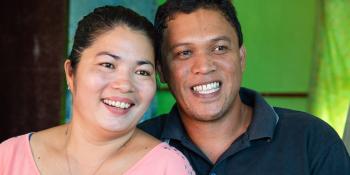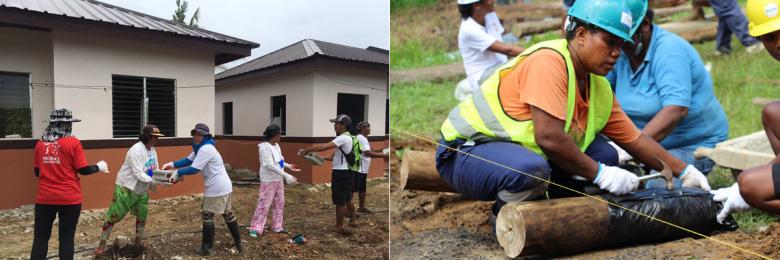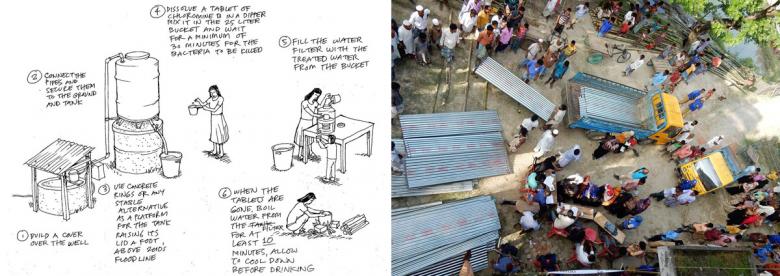
The subtitle goes here.
In the Asia-Pacific region, Habitat for Humanity’s disaster response efforts provide affected families with shelter assistance, education, training and partnerships.
MANILA (April 25, 2017) — Typhoon Haiyan turned Virgilio’s and Evangeline’s world upside down more than three years ago. “You go outside the house and see everything is collapsing. Your tears come out because you’re lucky to be alive.” Although it was one of the worst natural disasters ever to hit the Philippines, the typhoon did not destroy the couple’s life. They built a new home together with Habitat Philippines. “We are more stable because we own this house,” said Virgilio.
Philippines: Habitat continues to work in communities affected by Typhoon Haiyan (known locally as Yolanda) and the Bohol earthquake, both of which struck the country in late 2013. As of September 2016, Habitat has built 3,176 units in 17 municipalities in Bohol. By March 2017, Habitat has finished reconstructing over 2,500 out of a targeted 3,971 houses that were damaged or destroyed by Typhoon Haiyan and built an additional 39 community units. Please support this response.
Fiji: By March, Habitat Fiji had completed more than 150 houses, over a year after Tropical Cyclone Winston struck the Pacific Islands nation on February 20, 2016. Reconstruction continues with Habitat Fiji aiming to build a total of 500 new homes depending on the available funding. In cooperation with the government of Fiji, Habitat is increasing communities’ awareness and self-reliance through training in “Build Back Safer” construction techniques.

From March 29 to 31, Habitat Fiji’s first-ever Women Build brought together 20 participants including Anne Dunn, Miss Fiji and Miss Pacific Islands. The hands-on “Build Back Safer” training in Nakorovou village in Dreketi, Rewa, led to a new house for Selina. After Cyclone Winston, what remained of her old house – big enough to fit her bed – was destroyed by a fire some months later. “I am so blessed to finally have a decent home to live in,” said Selina.
According to assistant village chief, Bruce, it is considered a taboo for women to do construction work. But he said: “I believe they can do the same work that our men are capable of.” That sentiment is shared by Ruci, 24. “This was a great exposure for me as a mother and wife. I enjoyed learning about building a strong house in three days. It has empowered me as a woman and gave me the confidence to have more say at home when it comes to taking care of the house.”
To date, Habitat Fiji has worked with about 200 female community builders in its reconstruction efforts. Please support the cyclone response..
Apart from longer term commitments, Habitat has also responded to a slew of disasters in 2016 with the generous support of donors, partners and volunteers. Among these disasters are the floods, landslides and Cyclone Vardah in India; flooding in Vietnam and Thailand; Typhoons Haima and Nock-ten, locally known as Lawin and Nina respectively, in the Philippines and earthquakes in New Zealand and Indonesia.
Sri Lanka: In January 2017, a housing project broke ground in Kegalle district which was affected by landslides following Cyclone Roanu. With funding from Saudi Arabia-based charitable organization Alwaleed Philanthropies, Habitat Sri Lanka will build 19 houses in Yatiyantota and 23 houses in Deraniyagaka. Local and international volunteers are working alongside affected families to build disaster-resilient communities and reduce casualties. The houses are expected to be handed over by May 2017.
Bangladesh: Funding from the Jersey Overseas Aid Commission and Sailor Society, through Habitat Great Britain, is supporting 240 families in building new houses, making house retrofits and constructing disaster-resilient latrines. Habitat has also started a three-year urban disaster response and risk reduction project in March 2017 in Dhaka and Khulna through a consortium approach with Caritas Bangladesh and Caritas Switzerland with funding from JTI Foundation.
In November 2016, Habitat Bangladesh completed its response to Cyclone Roanu by distributing 2,400 emergency shelter kits to affected families. Each kit contained items such as corrugated roofing sheets, bamboo poles, steel nails, rope, hand saw, hammer and knife. The response was funded by the Government of Hong Kong Special Administrative Region. Another 47 families received temporary shelters with funding from the Korea International Cooperation Agency, Habitat Korea and Habitat Australia.

Vietnam: Habitat has helped a total of 16,080 families who were affected by flooding in October 2016. Water, sanitation and hygiene kits were distributed, each containing items that include a water filter, two bottles of disinfectant Chloramine B and a bucket. The families were also trained in water purification and hygiene promotion measures.
Other ongoing responses are in India, in areas affected by Cyclone Vardah, and floods and landslides in Assam; in Pidie Jaya, Indonesia, which was struck by a magnitude-6.4 earthquake; in Bicol province and in northern Philippines, which were devastated by Typhoons Nock-ten and Haima respectively; in southern Thailand, which experienced significant flooding that damaged over 500,000 homes.